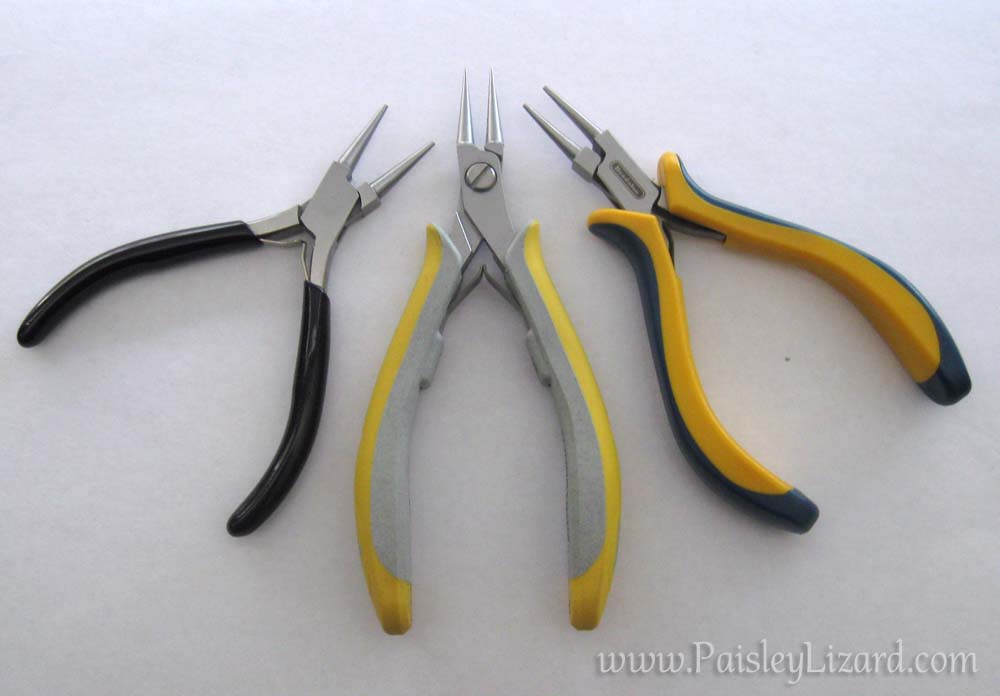
Thee brands of round nose jewelry pliers tested. From left to right: Beadsmith, Lindstrom, Beadalon.
I have been searching for the perfect pair of round nose pliers for my jewelry making. That’s not the reason I’ve neglected this blog, and you, my dear readers, for over two months. But the two things are not unrelated. You see, I moved in the spring and am just now getting back to my jewelry making.
My studio is still a wreck as I continue to sort out where to put away all the things that were packed and then unpacked. And I can’t find my pliers. I’ve unpacked every box. I don’t know if they are tucked away behind a pile I’ve yet to organize or whether I accidentally put them in one of the boxes of craft goodies that I donated. Or maybe I accidentally threw them away with a pile of packing paper?
After two months of searching around my new place for the little purple pencil box I remember putting my pliers in, I finally gave in and decided to buy a new set. And since I recently celebrated a birthday, I decided to splurge and get a matching set of Lindstrom pliers, all with ergonomic handles. I chose the EX series and ordered a set of four that included round nose, straight nose, chain nose, and flush cutters.
I’ve been working with wire and making jewelry for over 15 years using the pairs that are now missing. They weren’t “high-end” (I think I paid less than $15 per pair) and didn’t all have comfy cushioned or ergonomic handles. But they worked and I was used to them. I even had the round nose pliers marked with a Sharpie at two spots along the jaw – one for small loops and one for large loops.
When my Lindstrom’s arrived, I was very disappointed to find that the jaws on the round nose pliers had a substantial gap when closed. Why is a gap disappointing? If the jaws don’t come close enough to each other, you won’t be able to grip the wire as you try to form a loop. It will slip and slide and you will get wonky wobbly shapes rather than consistent loops.
The gap on this particular pair of round nose pliers was so large, wire thinner than 18 gauge could pass straight through. That’s a problem for me because I work primarily with 20 gauge and smaller wire.
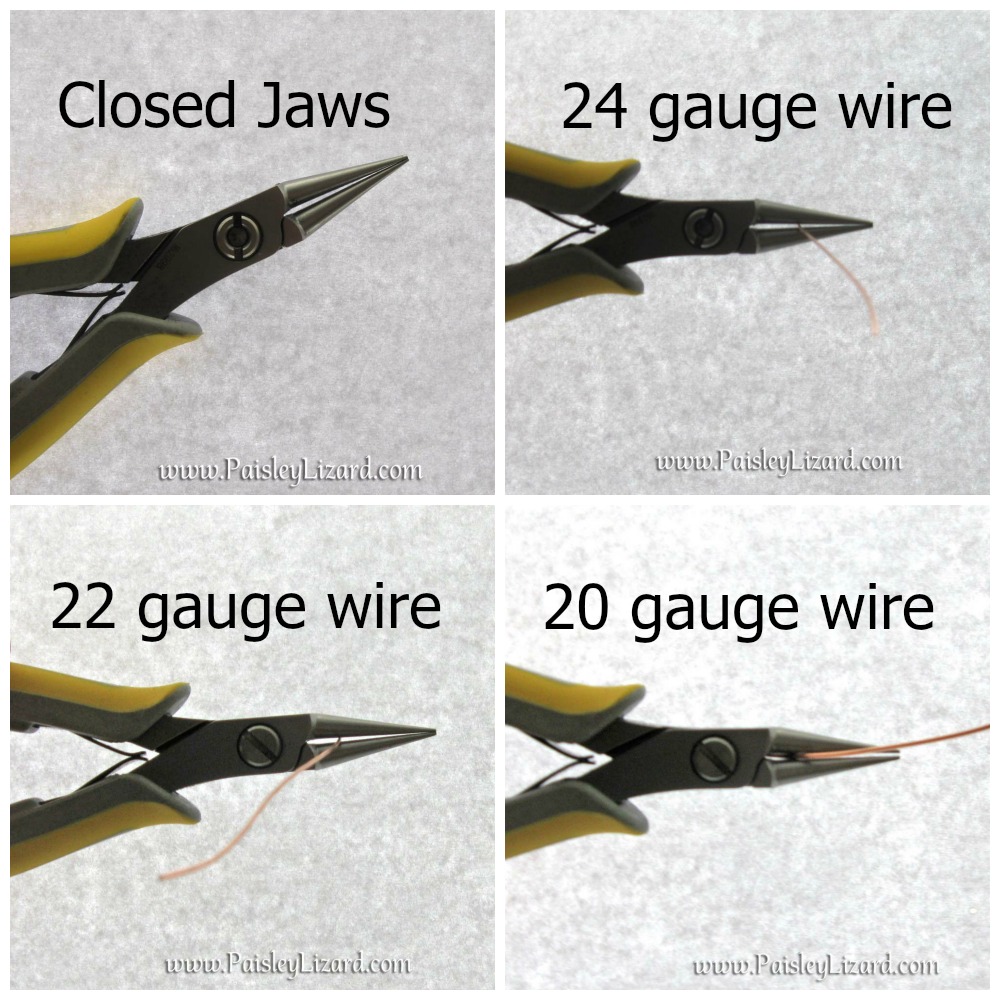
If you look closely, you can see the gap between the jaws on this pair of Lindstrom round nose pliers in the upper left image. The handles are fully closed and the jaws only connect at the tip. The other three images show the pliers closed with 24, 22, and 20 gauge wire. Notice that the thinner the wire is, the closer it must be to the tip to be grasped.
I was not expecting Lindstrom jewelry pliers to have a gap like this. I’ve seen it in some less expensive or discount brands and especially in those not specifically marketed as jewelry tools. Thinking I might have simply received a “bad” set, I contacted the supplier and asked if they could check whether all the pairs in their inventory had a gap.
I’m not going to mention the name of the online supplier I ordered from, but I will say their customer service representative clearly knew nothing about jewelry pliers. She referred me to a photo on their website which showed the pliers in the open position (similar to the first photo in this post), with the jaws no where near each other, and insisted they were closed and the jaws were not supposed to touch. I returned the set, after taking a few photos of them for this post.
I next ordered a couple of pairs of round nose pliers by different brands (and from a different supplier!) in hopes of finding the “just right” pair. One of the pair I ordered are the same brand (Beadsmith), and I think the same model, as my lost pair. Why didn’t I simply go back for another pair those in the first place? They don’t have the most comfortable handles. The other pair are a third brand (Beadalon), which do have ergonomic-looking handles. Here’s how the other two brands compare to the Lindstroms.
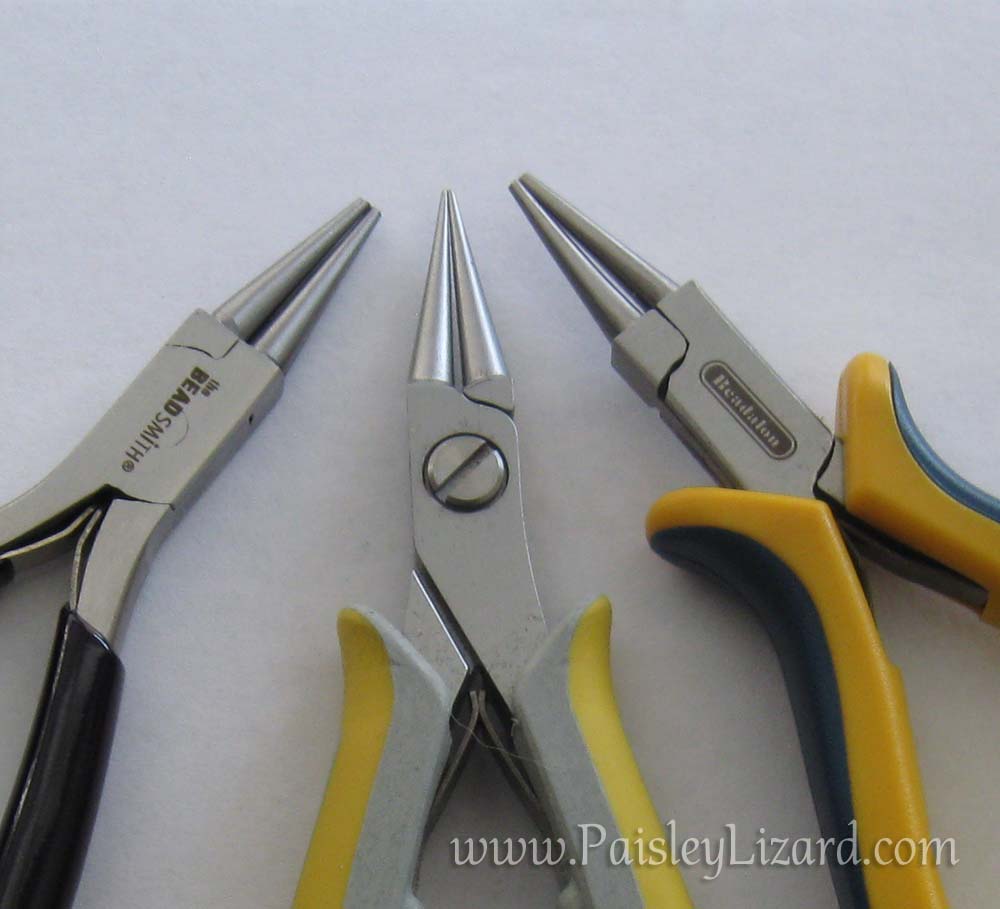
These three pairs of pliers are shown with their jaws closed. The brands are, from left to right: Beadsmith, Lindstrom, and Beadalon. Notice how finely tapered the tips are on the Lindstroms compared to other two.
It may not be immediately obvious from the photo that all three pair of round nose pliers have some kind of gap when the jaws are closed. The difference is that the gap in the Beadsmith (the same brand and my trusty missing pliers) is much smaller, and consistent along the length, compared to the other two brands. The gap in the Beadalon pair is about as wide as that in the Lindstroms. Here are some additional angles to better illustrate the gaps.
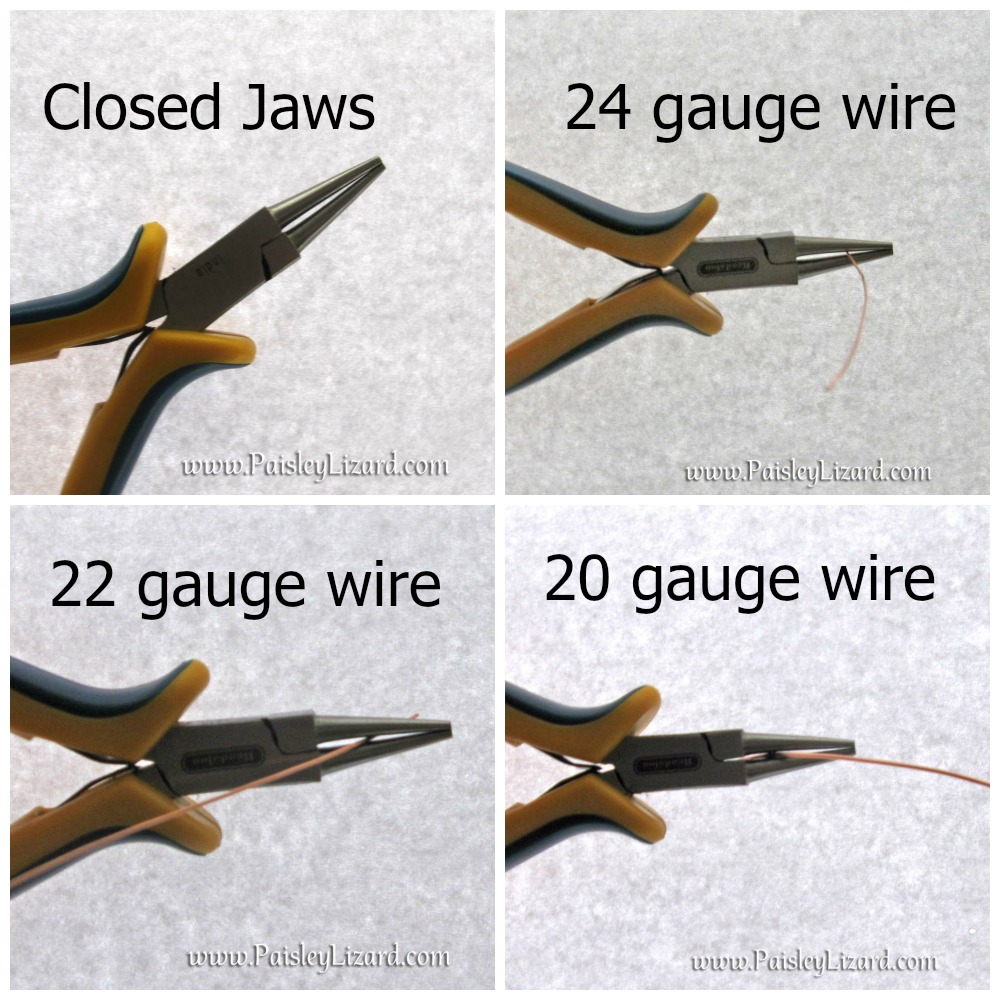
These are the Beadalon pliers, which have a gap between the jaws that is about the same as that on the Lindstroms. The jaws are closed in all four images. The thinner the wire is, the closer it must be to the tips to be held.
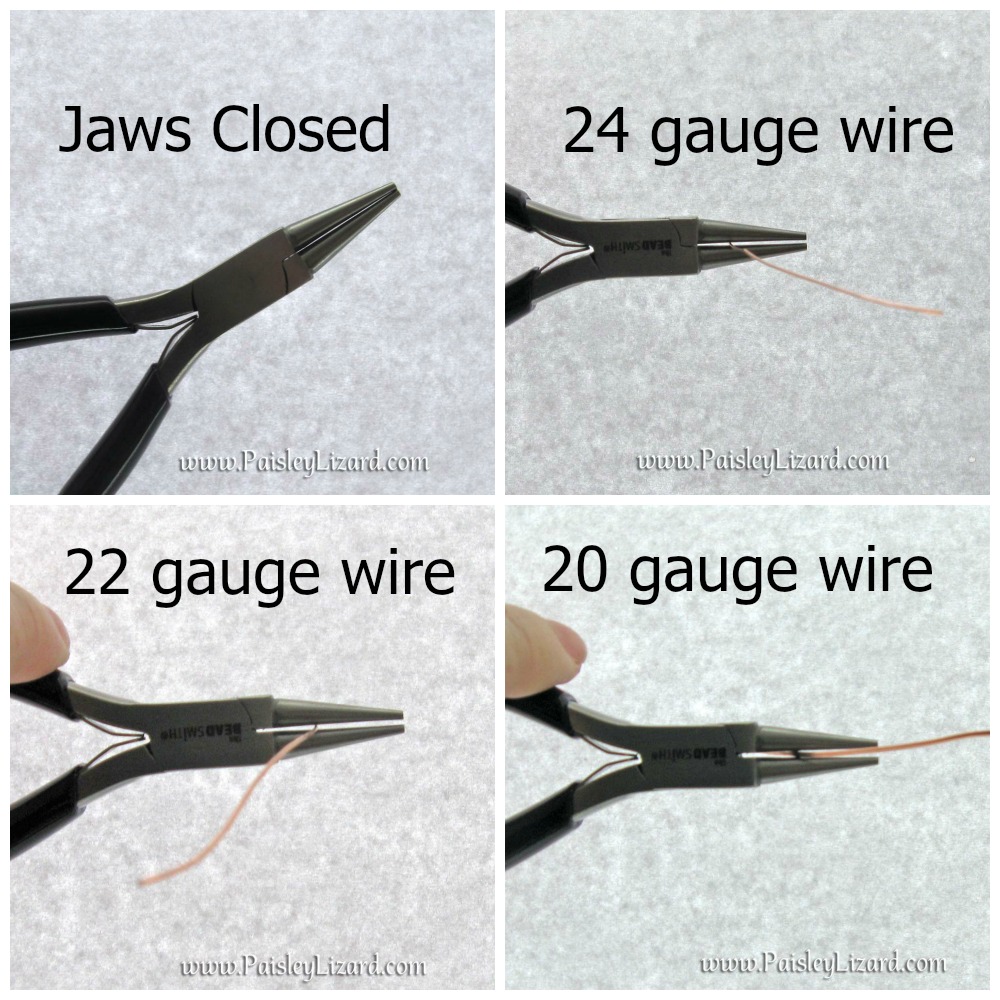
The gap between the jaws on these Beadsmith round nose pliers is barely noticeable. It is also consistent in width along the length of the jaws. They grip all gauges of wire equally well along their entire length. Note how the tips don’t connect when the jaws are gripping wire, regardless of the wire thickness. That’s because the gap doesn’t get wider as you move toward the base.
What I hope you can see from my “action shots” with the three brands holding various gauges of wire is that the Beadsmith brand have the best jaws in terms of gripping thinner wire There is a very thin gap between them, but unlike with the Lindstrom and Beadalon pliers, it doesn’t get wider as you move further from the tips. What that means is I can use them for even the thinnest wire in my jewelry making repertoire and not be limited to making only small loops with thiner wire.
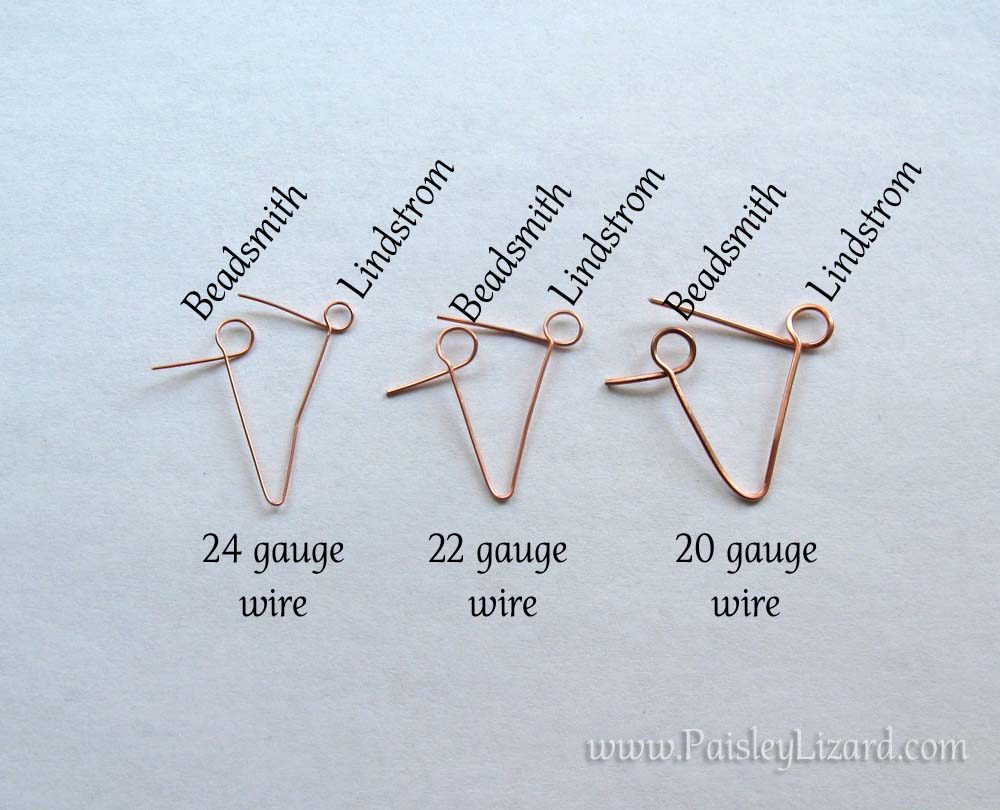
I made loops in three gauges of copper wire with the Beadsmith and the Lindstrom round nose pliers. I didn’t include loops made with the Beadalon pliers because they perform similarly to the Lindstroms in comparison to the Beadsmith. Notice that the loops made with the Beadsmith pliers are the same size regardless of wire gauge. In contrast, the loops made with the Lindstrom pliers are smaller with the thinner wire. That’s because I couldn’t grip the thinner wire along the wider parts of the jaws due to the gap between them
I am keeping the new Beadsmith pliers. They don’t have comfy ergonomic handles, but they allow me to make loops at any point along the jaws – small and large – with all of the gauges of wire I use. I am also keeping the Beadalon pliers because they may come in handy when I need to wrangle thicker wire, like 14 and 12 gauge, and don’t to overtax the jaws on the other pair. I don’t work with those thicker sizes often for making jewelry, but I do use it on occasion for other craft reasons.
Also, I haven’t given up on Lindstrom. The other three pair in the set were fine and feel very comfy to hold. In addition, a few people who own Lindstrom round-nose pliers assured me their pairs do not have jaws with wide gaps. So, it is possible I got a “bad” pair. I ordered a new set (the same four pair) from a different supplier, because I do still need flush cutters, chain nose, and straight nose pliers. They haven’t arrived yet, but I’ll keep you posted when I get them. Here’s hoping they meet my original expectations.

Terrific article! Thank you Tammy for writing up your research on these tools. You wonder if less or more dollars will get you the best product and your article showed how a less expensive tool could still do the job and do a better job!
Chris
Thank you, Chris. You can absolutely get by with less expensive. I used my original (lost) inexpensive pliers for over 15 years. The Lindstroms definitely feel better in my hand though. I imagine my hand would not ache (as much) after a day of wire working if I used them. I’m still hoping that gap is not typical for their round nose, and I do plan to replace my other pliers (needle nose, chain nose, etc.) with Lindstroms.